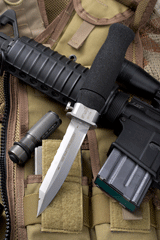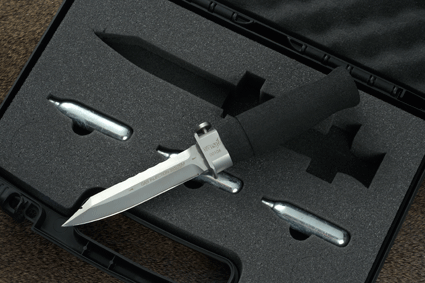In the past few years many have wondered if we have reached the apex of knife design. We have seen new materials being used in knife construction and there have been many new locking mechanisms for folding knives. On the other hand, the basic designs of fixed blade knives have not radically changed in eons. Please don’t take me wrong. Several new knives have come on the market that can only be deemed as outstanding. However, most of them are new combinations of a known handle style with a known blade pattern.
 You can sit back and relax; the idea that knife designs have become stagnant is about to be blown away, literally. A new knife, the WASP, is now being manufactured by WASP Injection Systems, Inc., and is marketed as a “Compressed Gas Injection Knife.” Unless you’ve seen their advertisements, you are probably wondering what in the world I’m talking about. It’s really rather straightforward; the WASP has a CO2 cartridge inserted into its handle and an exhaust port near the tip of the blade. Thrust the blade into an object, push the release button and you inject a charge of CO2 gas. Tactical Knives’ editor was the first to tell me about this knife. My first reaction was to wonder about the purpose of the design? After all, I’m a former engineer and designed the TOPS Harpoon. If anyone should take a serious look at the design, it should be me.
You can sit back and relax; the idea that knife designs have become stagnant is about to be blown away, literally. A new knife, the WASP, is now being manufactured by WASP Injection Systems, Inc., and is marketed as a “Compressed Gas Injection Knife.” Unless you’ve seen their advertisements, you are probably wondering what in the world I’m talking about. It’s really rather straightforward; the WASP has a CO2 cartridge inserted into its handle and an exhaust port near the tip of the blade. Thrust the blade into an object, push the release button and you inject a charge of CO2 gas. Tactical Knives’ editor was the first to tell me about this knife. My first reaction was to wonder about the purpose of the design? After all, I’m a former engineer and designed the TOPS Harpoon. If anyone should take a serious look at the design, it should be me.
The WASP is delivered in a foam-filled plastic case holding the knife and three extra CO2 cartridges. The package also includes a catalog of options and an instruction sheet. Forget the instruction sheet; I am all man and went straight to the catalog. The model that was sent to the studio was known as the “All Purpose Knife.” WASP Injection Systems also offers an “Aviation & Marine Safety Knife” and a “Special Ops/Tactical Knife.” Look closely and you will see that the only difference between the three is handle material and style. The blade is identical from model to model and is made of ¼-inch 440C stainless steel. The clip-point pattern has a small gas outlet hole bored from the handle towards the point along its centerline. This gas bore runs to within an inch of the tip before it sweeps upward to emerge out of the false edge of the clip point. The primary edge is flat ground and the spine of the blade is basically a false edge with the exception of a 2 ¼-inch area of sharpened serrations. The blade is welded to a guard/gas release hub and the handle holding the gas cylinder is screwed into this guard. The handle material for the sample was Neoprene and designed to hold a standard CO2 cartridge as commonly found on pellet rifles. Interchangeable handles are available in black or orange-colored rubber and about 18 various woods.
Advertisement — Continue Reading Below
The Reason Why
That is a simple description but it really doesn’t explain why a company would introduce such a knife. The answer is simple; if you find yourself in a dangerous situation—shark-infested waters, grizzly country, you get the idea—and the 5 inches of cold steel just won’t cause enough damage, push the button and you inject 40-plus cubic inches of compressed gas into the wound channel. According to WASP Injection Systems, the gas is expelled at 800 psi and should freeze surrounding tissue with its sub-zero temperature. OK, not your normal paper cut. Their catalog points out that if you’re a diver, you can defend yourself against a marine predator. They don’t mention sharks by name, but that is what I would worry about. Stab and inject that Great White and he should float to the surface before doing you any harm. Hiking the back woods full of lions, tigers and bears? Oh, my! To quote the brochure, “The effects of this injection will drop many of the world’s largest land predators.” The military/tactical use is also mentioned and you can imagine the surprise such a tool would give an enemy sentry.
All of this sounds really good if you’re in need of a defensive weapon, but you must be wondering if this new knife will live up to its advertising. If you’re waiting to hear how I went after bears, forget it! No, I didn’t even try to bait a shark or two. My wife made threats of her own once she saw me eyeing a rabbit in the yard. What I did do was have a conversation with my dog’s vet. It took a little explaining to get him to take me serious. He made me promise not to print his name or the name of his clinic but in his professional opinion, “That would hurt!” As with any weapon, he thought a lot would depend on the location of the wound, but no matter where you stabbed the animal, it should get his attention and deter a continuation of the attack. A chest wound should end the confrontation in seconds. From the vet’s office I headed to the emergency room of a local hospital. Again the results were the same, a lot of explanations on my part followed by a confirmation by the doctor that such a weapon would cause “severe distress!” For the past week I have been worrying that someone would come across a body full of cold air. The squad cars would be at my door in minutes.
Using Gunny’s Test Subject
How else do you test this weapon? If you ever watch Mail Call on the History Channel, you should have seen their usual stand-in for enemy soldiers, the deadly watermelon. Anything good enough for the Gunny is good enough for me. While I was expecting results, I will admit to being taken aback by the resulting damage. The plan was to inject the melon, slice it open, and measure the wound channel. I was even prepared to measure the depth of any freezing caused by the release of the CO2. In just a second the rind was flying apart and the fruit was decorating everything in a 10-foot radius. While the catalog claims you can use the knife for several charges, it took only a moment to empty the CO2 cartridge. Anyone buying the knife should waste a few cylinders in practice.
Advertisement — Continue Reading Below
There were a couple of items that should be mentioned. First, at the time of this writing, there is no sheath supplied with the knife. A quick call to the manufacturer confirmed that a sheath was in the design process. They also mentioned that aftermarket Nylon sheaths such as made by BlackHawk or Spec-Ops would work at this time. If you go this route, make sure that any retention strap does not come into contact with the gas release button. Once the cylinder is placed in the knife, the release button has only two modes: On and Off. There is no safety. A good waterproof sheath that covers the release button would be a welcome addition.
And It Cuts Too
After I emptied the gas cartridges on hand, it was time to find out how the knife worked as a cutting tool. The profile of the blade is similar to other combat/utility blades I have tried before and this knife proved to be acceptable in all of my cutting chores. The edge came from the factory razor sharp and the knife is more than capable of holding its own in the woods. Various ropes and webbing proved no problem to the serrations along the top of the blade. I wish I had more time to really evaluate the durability of the Neoprene handle but, as mentioned, the handles are interchangeable and can be ordered in just about any combination you can imagine.
There has already been a news article in British papers calling for a ban on this new and deadly weapon. That alone should justify checking out this new tool. I eagerly await a first-hand account of when this knife gets tested in a “Wasp versus Shark” situation.
Advertisement — Continue Reading Below
























